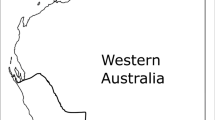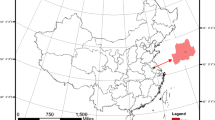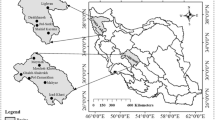Abstract
Nonlinear complexity is a characteristic of hydrologic processes. Using fewer model parameters is recommended to reduce error. This study investigates, and compares, the ability of gene expression programming (GEP) and artificial neural network (ANN) techniques in modeling ET0 by using fewer meteorological parameters in the karst area of northwest Guangxi province, China. Over a 5-year period (2008–2012), meteorological data consisting of maximum and minimum air temperature, relative humidity, wind speed, and sunshine duration were collected from four weather stations: BaiSe, DuAn, HeChi, and RongAn. The ET0 calculated by the FAO-56 PM equation was used as a reference to evaluate results for GEP, ANN, and Hargreaves models. The coefficient of determination (R 2) and the root mean square error (RMSE) were used as statistical indicators. Evaluations revealed that GEP, and ANN, can be used to successfully model ET0. In most cases, when using the same input variables, ANN models were superior to GEP. We then established ET0 equations with fewer parameters under various conditions. GEP can produce simple explicit mathematical formulations which are easier to use than the ANN models.



Similar content being viewed by others
References
Allen RG, Pereira LS, Raes D, Smith M (1998) Crop evapotranspiration: guidelines for computing crop water requirements. Irrigation and drainage paper 56. FAO, Rome
Cai ZH, Li Q, Jiang SW, Zhao YS (2004) Symbolic regression based on GEP and its application in predicting amount of gas emitted from coal face. Proceedings of the 2004 international symposium on safety science and technology:637–641
Droogers P, Allen RG (2002) Estimating reference evapotranspiration under inaccurate data conditions. Irrig Drain Syst 16(1):33–45
Falamarzi Y, Palizdan N, Huang YF, Lee TS (2014) Estimating evapotranspiration from temperature and wind speed data using artificial and wavelet neural networks (WNNs). Agric Water Manag 140:26–36
Ferreira C (2002) Gene expression programming in problem solving. Soft Computing and Industry. Springer London:635–653
Ferreira C (2006) Automatically defined functions in gene expression programming. Genetic Systems Programming: Theory and Experiences 13:21–56
Guven A, Aytek A (2009) New approach for stage–discharge relationship: gene-expression programming. J Hydrol Eng 14(8):812–820
Hu K, Wang S, Nie Y, Chen H (2014) Variations and impact factors of potential evapotranspiration in karst area of Northwest Guangxi over the last 60 years. Res Agric Modernization 35(4):500–506
Irmak S, Payero JO, Martin DL, Irmak A, Howell TA (2006) Sensitivity analyses and sensitivity coefficients of standardized daily ASCE-Penman-Monteith equation. J Irrig Drain Engi ASCE 132(6):564–578
Izadifar Z, Elshorbagy A (2010) Prediction of hourly actual evapotranspiration using neural networks, genetic programming, and statistical models. Hydrol Process 24(23):3413–3425
Karimaldini F, Shui LT, Mohamed TA, Abdollahi M, Khalili N (2012) Daily evapotranspiration modeling from limited weather data by using neuro-fuzzy computing technique. J Irrig Drain Eng ASCE 138(1):21–34
Khoob AR (2008) Comparative study of Hargreaves’s and artificial neural network’s methodologies in estimating reference evapotranspiration in a semiarid environment. Irrig Sci 26(3):253–259
Kim S, Kim HS (2008) Neural networks and genetic algorithm approach for nonlinear evaporation and evapotranspiration modeling. J Hydrol 351(3):299–317
Kim S, Shiri J, Kisi O, Singh VP (2013) Estimating daily pan evaporation using different data-driven methods and lag-time patterns. Water Resour Manag 27(7):2267–2286
Kim S, Shiri J, Singh VP, Kisi O, Landeras G (2014) Predicting daily pan evaporation by soft computing models with limited climatic data. Hydrological Sciences Journal (just-accepted)
Kisi O (2006a) Evapotranspiration estimation using feed-forward neural networks. Nord Hydrol 37(3):247–260
Kisi O (2006b) Generalized regression neural networks for evapotranspiration modelling. Hydrol Sci J J Des Sci Hydrol 51(6):1092–1105
Kisi O, Guven A (2010) Evapotranspiration modeling using linear genetic programming technique. J Irrig Drain Eng ASCE 136(10):715–723
Kumar M, Raghuwanshi NS, Singh R, Wallender WW, Pruitt WO (2002) Estimating evapotranspiration using artificial neural network. J Irr Drain Eng ASCE 128(4):224–233
Kumar M, Bandyopadhyay A, Raghuwanshi N, Singh R (2008) Comparative study of conventional and artificial neural network-based ETo estimation models. Irrig Sci 26(6):531–545
Kumar M, Raghuwanshi N, Singh R (2009) Development and validation of GANN model for evapotranspiration estimation. J Hydrol Eng 14(2):131–140
Kumar M, Raghuwanshi NS, Singh R (2011) Artificial neural networks approach in evapotranspiration modeling: a review. Irrig Sci 29(1):11–25
Ladlani I, Houichi L, Djemili L, Heddam S, Belouz K (2012) Modeling daily reference evapotranspiration (ET0) in the north of Algeria using generalized regression neural networks (GRNN) and radial basis function neural networks (RBFNN): a comparative study. Meteorog Atmos Phys 118(3–4):163–178
Landeras G, Lopez JJ, Kisi O, Shiri J (2012) Comparison of Gene Expression Programming with neuro-fuzzy and neural network computing techniques in estimating daily incoming solar radiation in the Basque Country (Northern Spain). Energy Convers Manag 62:1–13
Li Y, Horton R, Ren T, Chen C (2010) Prediction of annual reference evapotranspiration using climatic data. Agric Water Manag 97(2):300–308
Marti P, Gonzalez-Altozano P, Lopez-Urrea R, Mancha LA, Shiri J (2015) Modeling reference evapotranspiration with calculated targets. Assessment and implications. Agric Water Manag 149:81–90
Odhiambo LO, Yoder RE, Yoder DC, Hines JW (2001) Optimization of fuzzy evapotranspiration model through neural training with input–output examples. Trans ASAE 44(6):1625–1633
Parasuraman K, Elshorbagy A, Carey SK (2007) Modelling the dynamics of the evapotranspiration process using genetic programming. Hydrol Sci J 52(3):563–578
Pereira AR, Villa Nova NA, Pereira AS, Barbieri V (1995) A model for the class A pan coefficient. Agric For Meteorol 76(2):75–82
Rahimikhoob A (2010) Estimation of evapotranspiration based on only air temperature data using artificial neural networks for a subtropical climate in Iran. Theor Appl Climatol 101(1–2):83–91
Samadianfard S, Delirhasannia R, Kisi O, Agirre-Basurko E (2013) Comparative analysis of ozone level prediction models using gene expression programming and multiple linear regression. Geofizika 30(1):43–74
Shahrokhnia MH, Sepaskhah AR (2013) Single and dual crop coefficients and crop evapotranspiration for wheat and maize in a semi-arid region. Theor Appl Climatol 114(3–4):495–510
Shiri J, Kisi O (2011) Application of artificial intelligence to estimate daily pan evaporation using available and estimated climatic data in the Khozestan Province (South Western Iran). J Irrig Drain Eng 137(7):412–425
Shiri J, Kisi O, Landeras G, López JJ, Nazemi AH, Stuyt LC (2012a) Daily reference evapotranspiration modeling by using genetic programming approach in the Basque Country (Northern Spain). J Hydrol 414:302–316
Shiri J, Kisi O, Landeras G, Lopez JJ, Nazemi AH, Stuyt L (2012b) Daily reference evapotranspiration modeling by using genetic programming approach in the Basque Country (Northern Spain). J Hydrol 414:302–316
Shiri J, Sadraddini AA, Nazemi AH, Kisi O, Marti P, Fard AF et al (2013) Evaluation of different data management scenarios for estimating daily reference evapotranspiration. Hydrol Res 44(6):1058–1070
Shiri J, Marti P, Singh VP (2014) Evaluation of gene expression programming approaches for estimating daily evaporation through spatial and temporal data scanning. Hydrol Process 28(3):1215–1225
Shiri J, Marti P, Nazemi AH, Sadraddini AA, Kisi O, Landeras G et al (2015) Local vs. external training of neuro-fuzzy and neural networks models for estimating reference evapotranspiration assessed through k-fold testing. Hydrol Res 46(1):72–88
Sudheer KP, Gosain AK, Ramasastri KS (2003) Estimating actual evapotranspiration from limited climatic data using neural computing technique. J Irrig Drainage Eng ASCE 129(3):214–218
Trajkovic S (2005) Temperature-based approaches for estimating reference evapotranspiration. J Irrig Drain Eng 131(4):316–323
Trajkovic S, Kolakovic S (2009) Estimating reference evapotranspiration using limited weather data. J Irrig Drain Eng 135(4):443–449
Traore S, Guven A (2012) Regional-specific numerical models of evapotranspiration using gene-expression programming interface in Sahel. Water Resour Manag 26(15):4367–4380
Traore S, Guven A (2013) New algebraic formulations of evapotranspiration extracted from gene-expression programming in the tropical seasonally dry regions of West Africa. Irrig Sci 31(1):1–10
Wang ZK, Wu PT, Zhao XN, Cao XC, Gao Y (2014) GANN models for reference evapotranspiration estimation developed with weather data from different climatic regions. Theor Appl Climatol 116(3–4):481–489
Acknowledgments
The authors thank anonymous reviewers for their valuable and constructive comments. This study was supported by the National Key Basic Research Program of China (2015CB452703), the National Natural Science Foundation of China (41301300 and 51379205), the Natural Science Foundation of Hunan Province, China (14JJ3144), and the CAS “Light of West China” Program. Special thanks are also expressed to Stephen Laudig for checking the English of this paper.
Author information
Authors and Affiliations
Corresponding author
Rights and permissions
About this article
Cite this article
Wang, S., Fu, Zy., Chen, Hs. et al. Modeling daily reference ET in the karst area of northwest Guangxi (China) using gene expression programming (GEP) and artificial neural network (ANN). Theor Appl Climatol 126, 493–504 (2016). https://doi.org/10.1007/s00704-015-1602-z
Received:
Accepted:
Published:
Issue Date:
DOI: https://doi.org/10.1007/s00704-015-1602-z




